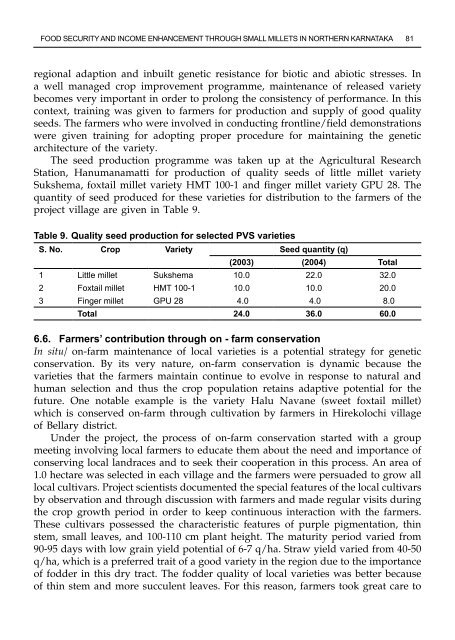Minor millets in South Asia: learnings from IFAD-NUS project in India ...
Minor millets in South Asia: learnings from IFAD-NUS project in India ...
Minor millets in South Asia: learnings from IFAD-NUS project in India ...
You also want an ePaper? Increase the reach of your titles
YUMPU automatically turns print PDFs into web optimized ePapers that Google loves.
Food seCuritY and <strong>in</strong>Come enhanCement through small <strong>millets</strong> <strong>in</strong> northern KarnataKa 81<br />
regional adaption and <strong>in</strong>built genetic resistance for biotic and abiotic stresses. In<br />
a well managed crop improvement programme, ma<strong>in</strong>tenance of released variety<br />
becomes very important <strong>in</strong> order to prolong the consistency of performance. In this<br />
context, tra<strong>in</strong><strong>in</strong>g was given to farmers for production and supply of good quality<br />
seeds. The farmers who were <strong>in</strong>volved <strong>in</strong> conduct<strong>in</strong>g frontl<strong>in</strong>e/field demonstrations<br />
were given tra<strong>in</strong><strong>in</strong>g for adopt<strong>in</strong>g proper procedure for ma<strong>in</strong>ta<strong>in</strong><strong>in</strong>g the genetic<br />
architecture of the variety.<br />
The seed production programme was taken up at the Agricultural Research<br />
Station, Hanumanamatti for production of quality seeds of little millet variety<br />
Sukshema, foxtail millet variety HMT 100-1 and f<strong>in</strong>ger millet variety GPU 28. The<br />
quantity of seed produced for these varieties for distribution to the farmers of the<br />
<strong>project</strong> village are given <strong>in</strong> Table 9.<br />
Table 9. Quality seed production for selected PVS varieties<br />
S. No. Crop Variety Seed quantity (q)<br />
(2003) (2004) Total<br />
1 little millet sukshema 10.0 22.0 32.0<br />
2 Foxtail millet hmt 100-1 10.0 10.0 20.0<br />
3 F<strong>in</strong>ger millet gpu 28 4.0 4.0 8.0<br />
Total 24.0 36.0 60.0<br />
6.6. Farmers’ contribution through on - farm conservation<br />
In situ/ on-farm ma<strong>in</strong>tenance of local varieties is a potential strategy for genetic<br />
conservation. By its very nature, on-farm conservation is dynamic because the<br />
varieties that the farmers ma<strong>in</strong>ta<strong>in</strong> cont<strong>in</strong>ue to evolve <strong>in</strong> response to natural and<br />
human selection and thus the crop population reta<strong>in</strong>s adaptive potential for the<br />
future. One notable example is the variety Halu Navane (sweet foxtail millet)<br />
which is conserved on-farm through cultivation by farmers <strong>in</strong> Hirekolochi village<br />
of Bellary district.<br />
Under the <strong>project</strong>, the process of on-farm conservation started with a group<br />
meet<strong>in</strong>g <strong>in</strong>volv<strong>in</strong>g local farmers to educate them about the need and importance of<br />
conserv<strong>in</strong>g local landraces and to seek their cooperation <strong>in</strong> this process. An area of<br />
1.0 hectare was selected <strong>in</strong> each village and the farmers were persuaded to grow all<br />
local cultivars. Project scientists documented the special features of the local cultivars<br />
by observation and through discussion with farmers and made regular visits dur<strong>in</strong>g<br />
the crop growth period <strong>in</strong> order to keep cont<strong>in</strong>uous <strong>in</strong>teraction with the farmers.<br />
These cultivars possessed the characteristic features of purple pigmentation, th<strong>in</strong><br />
stem, small leaves, and 100-110 cm plant height. The maturity period varied <strong>from</strong><br />
90-95 days with low gra<strong>in</strong> yield potential of 6-7 q/ha. Straw yield varied <strong>from</strong> 40-50<br />
q/ha, which is a preferred trait of a good variety <strong>in</strong> the region due to the importance<br />
of fodder <strong>in</strong> this dry tract. The fodder quality of local varieties was better because<br />
of th<strong>in</strong> stem and more succulent leaves. For this reason, farmers took great care to

















